Stomp you later, Jenrry. Stomp you later forever…
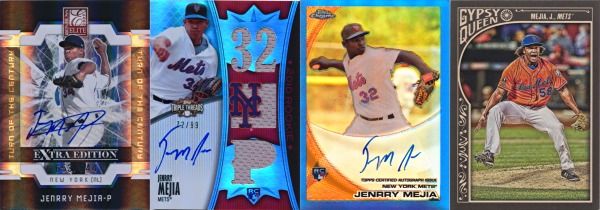 Plenty has already been written about Jenrry Mejia’s stunning fall from grace and far more will be written needlessly. Ted Berg sums things up nicely without any of the sanctimonious moralizing that hacks and blowhards rely on in place of actual discussion about performance enhancing drug use in baseball. As tends to be the case, what we know is dwarfed by what we don’t know and what we don’t know that we don’t know. In the end, it’s a sad story with many questions and few answers.
Plenty has already been written about Jenrry Mejia’s stunning fall from grace and far more will be written needlessly. Ted Berg sums things up nicely without any of the sanctimonious moralizing that hacks and blowhards rely on in place of actual discussion about performance enhancing drug use in baseball. As tends to be the case, what we know is dwarfed by what we don’t know and what we don’t know that we don’t know. In the end, it’s a sad story with many questions and few answers.
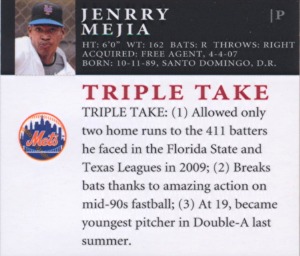
The story also plays out in Mejia’s cards, where we see him go from top prospect to Rookie to forgotten and back in the span of six years. The back of his 2010 Topps Triple Threads card tells a fairly standard origin story; Mejia signed as an international free agent out of the Dominican Republic at the age of 17 in 2007. Two years later, he was the youngest pitcher in AA and had a bright future ahead of him. What the card doesn’t say though is that this is when it all started to go wrong.
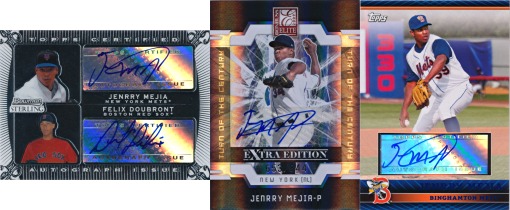 The 2009-2010 offseason is when Jenrry Mejia first took up the mantle of top prospect in the Mets system. Topps and Donruss took note, with Topps the first to feature Mejia’s signature on a dual autograph card in 2009 Bowman Sterling. Donruss followed suit one week later with base and autograph cards in 2009 Donruss Elite Extra Edition. Finally, Topps would issue Mejia’s last prospect autograph in 2010 Topps Pro Debut. This would be the first, and only until Desmond Lindsay in 2016, Mets autograph to appear in a Pro Debut product. Mejia became a rare top prospect without a Bowman Chrome prospect autograph due to a looming shakeup in the Mets front office.
The 2009-2010 offseason is when Jenrry Mejia first took up the mantle of top prospect in the Mets system. Topps and Donruss took note, with Topps the first to feature Mejia’s signature on a dual autograph card in 2009 Bowman Sterling. Donruss followed suit one week later with base and autograph cards in 2009 Donruss Elite Extra Edition. Finally, Topps would issue Mejia’s last prospect autograph in 2010 Topps Pro Debut. This would be the first, and only until Desmond Lindsay in 2016, Mets autograph to appear in a Pro Debut product. Mejia became a rare top prospect without a Bowman Chrome prospect autograph due to a looming shakeup in the Mets front office.
Coming into the 2010 season, Mets GM Omar Minaya and manager Jerry Manuel were in the last year of their respective contracts. After coming within a swing of the World Series in 2006, the pair fell a game short of the postseason in 2007 and 2008 before falling flat in 2009. Jobs on the line, they were desperate for something to prop up a team that wasn’t poised to do much better than it had the previous year. So they opted to promote 20 year old Jenrry Mejia from AA straight into the 2010 Opening Day roster.
Mejia wasn’t ready. Even at the time, people who had been watching him knew that he needed some work to develop his secondary pitches. And it was doubtful that he would be able to turn around a team that was collapsing under the weight of bad contracts and aging players. But at least he would gain experience, right? Not exactly. Rather than use their top prospect stud pitcher in an important role or even any defined role, Manuel and Minaya gave Mejia mop up duty and low leverage spots, exactly the wrong thing for a pitcher you’re trying to develop or even just extract some value out of. Like much of Mejia’s story, it made no sense at the time and is still impossible to understand now. A predictable bust, Mejia was sent down to the minors to be stretched out into a starter.
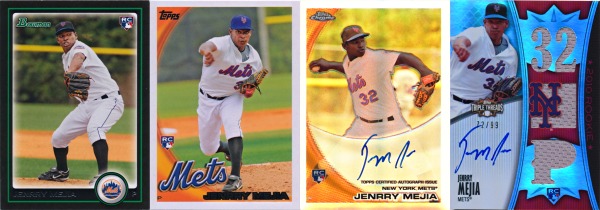
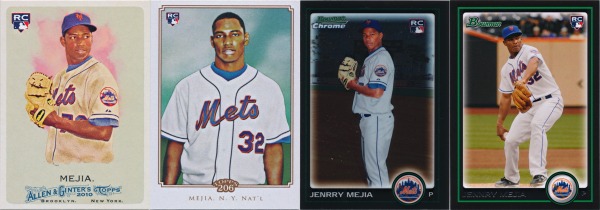 We don’t really know how much damage that experiment did to Mejia mentally and physically. But the momentary positive impact was that it made him eligible for Rookie Cards! Yeah, not really a fair trade-off. It did give us autographs in 2010 Topps Chrome and autographed memorabilia cards in 2010 Topps Triple Threads at least. His cardboard future, if nothing else, still looked bright.
We don’t really know how much damage that experiment did to Mejia mentally and physically. But the momentary positive impact was that it made him eligible for Rookie Cards! Yeah, not really a fair trade-off. It did give us autographs in 2010 Topps Chrome and autographed memorabilia cards in 2010 Topps Triple Threads at least. His cardboard future, if nothing else, still looked bright.
And then came the predictable injury. With Minaya and Manuel out of the picture, Mejia was still dealing with the impact of their decisions. He might have been headed toward Tommy John surgery anyway, but it’s hard to imagine that his treatment during 2010 didn’t contribute in some way. There was no sense of shock or surprise at the news, just sad resignation to the apparent fact that reckless handling by bad management had set Mejia back at least two years. With their toys about to be taken away, Minaya and Manuel took the shiny new one off the shelf, ripped it out of its packaging, and smashed it on the floor. Mejia’s tiny head on a 2011 Topps Heritage card would be his only cardboard appearance of 2011 and his last for more than two years.
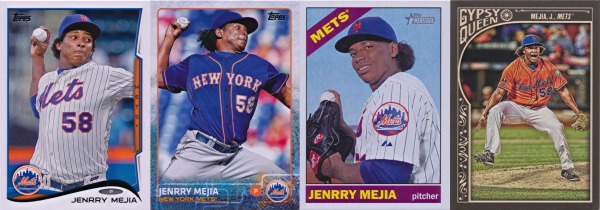 After missing most of 2011 and 2012 and then having his 2013 comeback cut short due to injury, Jenrry Mejia came into 2014 looking to finally make his mark. His 2013 season gave reason to believe that he could still be an effective starter, but that soon faded. Needing something to shake up the team, the Mets moved Mejia into the bullpen and eventually into the closer role. Here, he thrived, thrilling fans with his pitching and his celebratory theatrics. After losing Bobby Parnell to Tommy John surgery at the start of the season, the Mets had a new stud closer.
After missing most of 2011 and 2012 and then having his 2013 comeback cut short due to injury, Jenrry Mejia came into 2014 looking to finally make his mark. His 2013 season gave reason to believe that he could still be an effective starter, but that soon faded. Needing something to shake up the team, the Mets moved Mejia into the bullpen and eventually into the closer role. Here, he thrived, thrilling fans with his pitching and his celebratory theatrics. After losing Bobby Parnell to Tommy John surgery at the start of the season, the Mets had a new stud closer.
But Mejia didn’t exactly walk off into the sunset after the 2014 season. The following offseason, he would test positive for steroids, one of several positives for old-school steroids that had MLB searching for answers and fans seeing Mejia’s antics in a new light. Now out for 80 games at the start of the season and ineligible for the postseason, Mejia saw his closer role fall to Jeurys Familia, who excelled in a more subdued fashion. When he came back, Mejia was just another reliever in the mix for late inning spots. But that didn’t last long; just two weeks into his return, word came down that he had failed a second test while serving his initial suspension. Just like that, Mejia had another lost season ahead of him, seemingly his own doing this time.
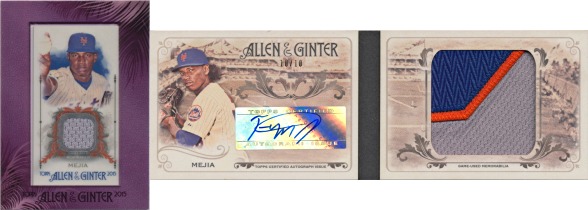 By then, Topps was clearly through with all things Jenrry Mejia. After appearing in several products early in the season, planned well before his first positive test had been announced, Mejia’s final appearance came in July’s 2015 Topps Allen & Ginter, where Topps burned off their remaining supply of Jenrry Mejia memorabilia and autograph stickers just a week before his second positive test was announced. There’s probably some more stashed away somewhere, but this should be the last we see of Mejia in premium cardboard. Two positive tests should certainly keep him out of consideration for anything more than an occasional base card.
By then, Topps was clearly through with all things Jenrry Mejia. After appearing in several products early in the season, planned well before his first positive test had been announced, Mejia’s final appearance came in July’s 2015 Topps Allen & Ginter, where Topps burned off their remaining supply of Jenrry Mejia memorabilia and autograph stickers just a week before his second positive test was announced. There’s probably some more stashed away somewhere, but this should be the last we see of Mejia in premium cardboard. Two positive tests should certainly keep him out of consideration for anything more than an occasional base card.
But three positive tests? That makes you ineligible to appear on a Topps card. Or in baseball games. Forever* (*minimum of two years, thereafter subject to annual requests for reinstatement). We are all at a loss to explain what happened here. Chances are, we will never know the full truth behind one of the more bizarre careers in Mets history. But the rise, fall, rebirth, and fall from grace of Jenrry Mejia has left its mark on the baseball cards of the time, both in the ones that were made and the ones that weren’t (and may never be made again).

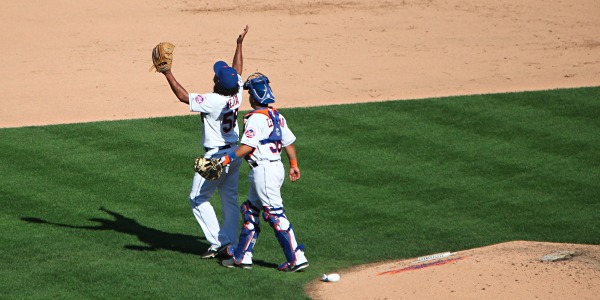
Comments are closed.